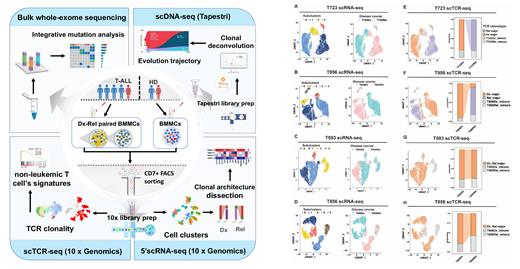Occurrences of T-cell acute lymphoblastic leukemia (T-ALL) arise in approximately 10-15% of pediatric ALL cases and the outcomes for high-risk T-ALL are inferior. Currently, the precise dissection of clonal evolution with intra-tumoral heterogeneity and to delineate targetable molecular events driving relapse in T-ALL subtypes have become area of interest.
We carried out high-throughput droplet-based 5′-single-cell RNA-sequencing (scRNA-seq) and paired T-cell receptor sequencing (scTCR-seq) of isolated CD7 + BMMCs from five patients' Dx_Rel paired samples. To investigate the gene signature variation underlying leukemic progression, we observed two distinct patterns of evolutionary trajectories in the four Dx_Rel nonETP-ALL pairs. From T956 and T723, a significant outgrowth in TCR initially negligible diagnostic subclusters at relapse, to which surrogate TCR repertoires were correspondingly linked and enumerated, suggestive robust dominant “clonal shifts” under continuous chemotherapeutic pressure. Whereas in Dx_Rel pairs T593 and T856, which contained subclusters with distinct gene signatures at diagnosis or relapse respectively, shared an identical TCR genotype (TCR Dx-Rel major clone). The clonal architecture clues gained from simultaneous scRNA-seq and scTCR-seq are strongly indicative of the leukemic “clonal drift” that commonly occurs under chemotherapeutic stress, during which somehow, hypothetically, molecular signatures within the same TCR subclones intrinsically progressed over time ( Fig. A-H). Next, we designed a targeted scDNA-seq library within a custom panel covering 127 amplicons and 102 genes via Tapastri platform to validate these two patterns of clonal evolution during leukemia progression unambiguously. Likewise, we captured that in persisted subclones in T593 and T856 leukemic cells attained reproductive fitness from maintaining a mutational static status with remarkable transcriptomic variation from diagnosis to relapse.
To further interpret the transcriptomic signature drift in the persisted TCR-defined major clones from T593 and T856 pairs, differential expression analysis was employed with RNA-binding protein Musashi-2 (MSI2) showing the most prominent differential expression pattern across drifted subclones catching our attention as a potential indicator of intrinsic clonal progression related to chemo-resistance. Comprehensive analysis of RNA-seq data from the CCCG-ALL-2015 cohort (n=72) and TARGET T-ALL cohort (n = 264) revealed that higher levels of MSI2 mRNA expression in pediatric T-ALL were correlated with higher measurable residual disease (MRD) after induction, and significant correlation between elevated MIS2 mRNA and resistance to prednisone, daunorubicin, and cytarabine were observed from ex vivo drug response assay. RNA immunoprecipitation and high-throughput mRNA sequencing from T-ALL cell lines detected a consistent significant enrichment of MYC transcript peaks in three T-ALL cell lines, indicating the molecular mechanism of MSI2 upregulation on MYC in the progression of T-ALL. Finally, In vitro and in vivo pharmacotyping analysis further validated the MSI2 inhibition significantly sensitized T-ALL to the chemotherapeutic drugs.
Collectively, our study leveraging single-cell multi-omics profiling has provided a snapshot of the clonal architecture evolution that occurs from diagnosis to relapse in T-ALL, proving the coexistence of “clonal shift” and “clonal drift” in leukemic progression. Systemic analysis of drifted T-ALL clones has provided compelling evidence of the posttranscriptional regulatory effect of MSI2 on MYC and its potential correlation with leukemic reoccurrence, pinpointing MSI2 as a promising drug target of T-ALL in the future practice.
Disclosures
No relevant conflicts of interest to declare.


This feature is available to Subscribers Only
Sign In or Create an Account Close Modal